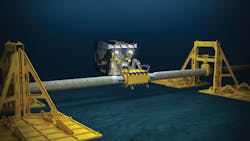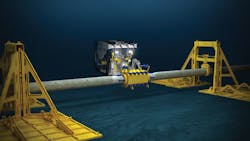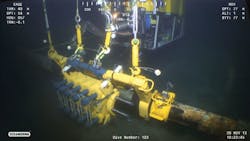Project management, technology enable timely deepwater pipeline repair
Tool modifications enable quick mobilization on West Africa project
John Charalambides
Oceaneering International Inc.
Subsea repair ofpipelines in deepwater is a complex and challenging operation that involves the use of remotely operated vehicles (ROVs) to deploy specialized tooling, clamps, and connectors. Pipeline repair also requires the engineering, logistics, and deployment of a range of other equipment, including pipe lift frames, a vessel to support lifting, diving, and ROV operations, along with the ROVs themselves and the associated tooling. Specialized equipment may need to be modified or built from scratch and deployed on short notice to meet requirements. A recent project in West Africa demonstrates the range of capabilities required for a successful deepwater pipeline repair operation.
Pipeline leak detected
Offshore West Africa, during a routine pressure test of a 20 year-old, 10-in. oil production pipeline in 2,400 ft (731 m) of water, the operator detected a leak as part of the test’s visual inspection. At this depth, the ambient pressure of the seawater was higher than the pipeline’s operating pressure. Water could enter the product stream and potentially create line-blocking hydrates, requiring additional separation and treatment at the surface. The small leak could possibly increase over time, which could in turn potentially pose a serious threat to the environment and require the operator to stop production.
The ROV visual survey did not find any visible damage to the pipeline, so it could be repaired using a structural clamp. However, the line’s protective coating would have to be removed from the general area of the leak to locate its exact location and to provide a clean surface for clamp installation.
Smart Clamp reconfigured
The operator authorized a front-end engineering and design (FEED) study to identify the requirements and risks associated with repairing the pipeline. Engineers determined that the pipeline could be repaired using an Oceaneering Smart Clamp to seal off the localized damaged area. Structural Smart Clamps have elastomeric seals and metal grips to stop the pipeline from leaking while also providing structural attachment to the parent pipeline. Such structural clamps are considered permanent repairs. When used to repair pipelines in water depths less than 1,000 ft (304 m), Smart Clamps are typically installed by divers. In deepwater applications, the clamps must have ROV-compatible bolts and actuating systems which require long fabrication lead times. To save time, the engineering team at Oceaneering, the pipeline repair contractor, immediately began working to modify an available, off-the-shelf, diver-installed structural Smart Clamp so it could be installed remotely in deepwater by a work-class ROV.
Dual-layer coating
The damaged line was protected by a 4.6-mm layer of standard fusion-bonded epoxy (FBE) coating and a 4-in. layer of glass syntactic polyurethane (GSPU). GSPU is insulation material with high-strength hollow glass microspheres mixed in to provide improved thermal insulating properties. Special tooling would be required to clean the GSPU from the pipe, as it is difficult to remove.
Staging repair equipment
Like many companies working in deepwater, the operator in West Africa had invested in pipeline repair equipment to have on hand for quick response to a pipeline failure. In this case, the operator had ROV tooling for FBE removal and the pipeline lift frames to raise the line above the seafloor at its shore base in West Africa. However, this equipment had not been maintained for several years and would need to be refurbished to perform repairs on the damaged line. The operator sent photographs of the equipment to the pipeline repair contractor, where engineers evaluated the equipment and ordered the required parts so that they could be on the ground in West Africa before the repair crew arrived.
An FBE coating removal tool, modified to remove the hard GSPU coating, was also shipped from the contractor’s facility in Houston to West Africa. The coating removal tooling included both a high-pressure water jet and a milling head to remove the GSPU and FBE.
Within a few weeks, all the equipment was ready, including the required spare parts, which the operator shipped to location within its vessel schedule requirements. The contractor’s team completed the upgrade to the pipeline lift frames and FBE removal tool at its own operating base in the West African country. The proximity of this facility contributed to having equipment ready within the project’s schedule.
Project implementation
The repair project was carried out with a third-party support vessel and two ROVs, previously contracted by the operator, under the project management of the pipeline repair contractor. The first step was to set the pipeline lift frames on either side of the damaged pipe section and then raise the line above the seafloor to enable coating removal and clamp installation.
Next, the protective GSPU and FBE coating were removed, using the ROV-operated tools. The pipeline’s weld seam was then milled off to create a smooth and round surface for the clamp. The clamp was lowered by crane from the service vessel and placed around the prepared pipeline location. An ROV was used to tighten the bolts on the clamp in sequence, starting from its center and working out to its ends, assuring that the elastomer seal were evenly compressed between the upper and lower sections. The clamp was then tested to verify seal integrity and the lift frames were lowered to reset the repaired pipeline on the seafloor, at which point the lift frames were retrieved to the surface. The permanent repair was completed in nine days, installing a structural clamp to enable oil to flow through the pipeline without leaks or water influx.
Be prepared
To be prepared to respond to pipeline failure, experts recommend that operators maintain emergency pipeline repair inventories, including one clamp and two smart connectors, for every size of pipeline in operation, both ROV installable. For deepwater pipelines and remote locations, it is good practice to have pipeline lift frames as well as ROV tools for pipeline repair kept on hand and in good working order.
In addition, project management is an important aspect of pipeline repair operations. Pipeline owners can benefit from having a single project manager who can effectively coordinate the activities of the numerous service disciplines required for pipeline repair.


